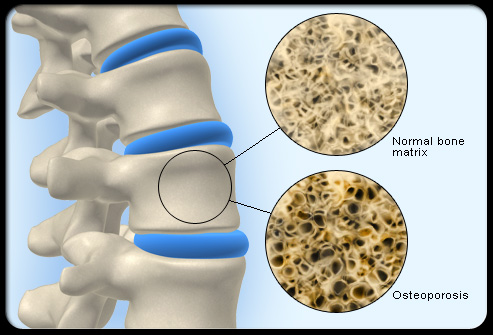Prevention and Treatment: Exercise
Exercise has a wide variety of beneficial health effects. However, exercise does not bring about substantial increases in bone density. The benefit of exercise for osteoporosis has mostly to do with decreasing the risk of falls, probably because balance is improved and/or muscle strength is increased. Research has not yet precisely determined what type or duration of exercise is best for osteoporosis. Nevertheless, most doctors recommend weight-bearing exercise, such as walking, preferably daily.A Word of Caution About Exercise
It is important to avoid exercises that can injure already weakened bones. In patients over 40 and those with heart disease, obesity, diabetes mellitus, and high blood pressure, exercise should be prescribed and monitored by their doctors. Finally, extreme levels of exercise (such as marathon running) may not be healthy for the bones. Marathon running in young women that leads to weight loss and loss of menstrual periods can actually cause osteoporosis.Prevention and Treatment: Quit Smoking and Curtail Alcohol
Smoking one pack of cigarettes per day throughout adult life can itself lead to loss of 5%-10% of bone mass. Smoking cigarettes decreases estrogen levels and can lead to bone loss in women before menopause. Smoking cigarettes can also lead to earlier menopause.Data on the effect of regular consumption of alcohol and caffeine on osteoporosis is not as clear as with exercise and cigarettes. In fact, research regarding alcohol and caffeine as risk factors for osteoporosis shows widely varying results and is controversial. Certainly, these effects are not as powerful as other factors. Nonetheless, moderation of both alcohol and caffeine is prudent.
Prevention and Treatment: Calcium Supplements
Building strong and healthy bones requires an adequate dietary intake of calcium and exercise beginning in childhood and adolescence for both sexes. Importantly, once osteoporosis is present, a high dietary calcium intake or taking calcium supplements alone is not sufficient in treating osteoporosis and should not be viewed as an alternative to or substituted for more potent prescription osteoporosis medications. In the first several years after menopause, rapid bone loss can occur even if calcium supplements are taken.Unfortunately, surveys have shown that the average woman in the United States consumes less than 500 milligrams of calcium per day in her diet, less than the recommended amounts. Additional calcium can be obtained by drinking more milk and eating more yogurt or cottage cheese or by taking calcium supplement tablets as well from calcium-fortified foods, such as orange juice.
Prevention and Treatment: Calcium-Fortified Foods
Excluding dairy products, the average American diet contains approximately 250 mg of calcium. As mentioned on the previous slide, here are some examples of calcium-fortified foods and their respective calcium intake.
Prevention and Treatment: Vitamin D
An adequate calcium intake and adequate body stores of vitamin D are important foundations for maintaining bone density and strength. Unfortunately, vitamin D deficiency is quite common in the United States. Vitamin D is important in several respects:- vitamin D helps the absorption of calcium from the intestines;
- a lack of vitamin D causes calcium-depleted bone (osteomalacia), which further weakens the bones and increases the risk of fractures; and
- vitamin D, along with adequate calcium (1,200 mg of elemental calcium), has been shown in some studies to increase bone density and decrease fractures in older postmenopausal but not in premenopausal or perimenopausal women.
- 200 IU daily for men and women 19 to 50 years old;
- 400 IU daily for men and women 51 to 70 years old; and
- IU daily for men and women 71 years and older.
Prevention and Treatment: Menopausal Hormone Therapy
Menopausal hormone therapy (previously referred to as hormone replacement therapy or HRT) has been shown to prevent bone loss, increase bone density, and prevent bone fractures. Estrogen is available orally (Premarin, Estrace, Estratest, and others) or as a skin patch (Estraderm, Vivelle, and others). Estrogen is also available in combination with progesterone as pills and patches.Prevention and Treatment: Medications
Currently, the most effective medications for osteoporosis that are approved by the FDA are anti-resorptive agents, which prevent bone breakdown. Antiresorptive medications inhibit bone removal (resorption), thus tipping the balance in favor of bone rebuilding and increasing bone density. Menopausal estrogen hormone therapy is one example of an antiresorptive agent. Others include alendronate (Fosamax), risedronate (Actonel), raloxifene (Evista), ibandronate (Boniva), calcitonin (Calcimar), and zoledronate (Reclast).Selective estrogen receptor modulators (SERMs) are a class of drugs that work like estrogen in some tissues. The SERMs are developed to reap the benefits of estrogen while avoiding the potential side effects of estrogen. Examples include tamoxifen and Raloxifene (Evista).












